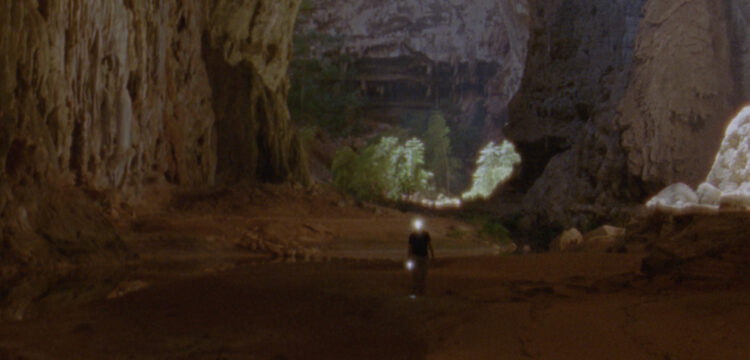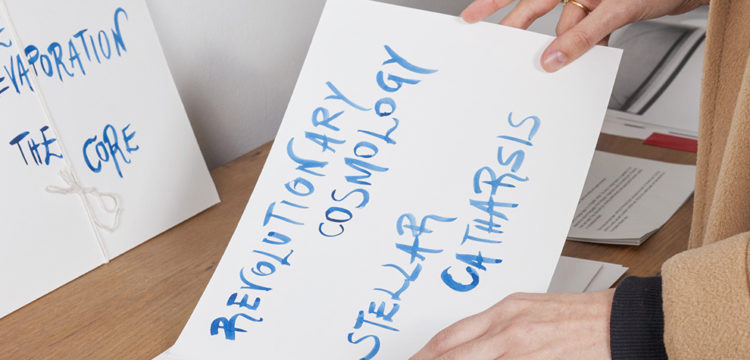Landscape Or Mirage?
Alessandro Vizzini at Fondazione Pastificio Cerere
Through a series of works from 2017 and a body of new works now on view at Fondazione Pastificio Cerere in Rome, Vizzini offers a negotiation between human vision and its cognitive construction and decoding operations, showing the illusions of human memory, the fictions of reality and the end of nature as we know it. The unconscious, dreams and their projections enter into the structure of the exhibition as modes of observation, reflections and mirages, distilling in the landscape a reciprocal relationship of knowledge and infused communication, where empathy for the environment coincides with an attempt to reconnect with the formalizing relationships of natural processes.
Favoring sculpture as a means of representation, Alessandro Vizzini bases his artistic research on the process of landscape observation and the reworking of such scenarios by exploring and overturning the drifts of the modernist relationship between human beings and the habitat they are part of. Vizzini’s works share strongly distinctive formal qualities, in which the object essence of sculpture is enlivened by the narrative aspect it contains. Temporal effects on visual matter and the presence of man as a privileged observer of nature are the central elements in the artist’s work.
Moving between present, past and future, and creating a bridge between projected and pre-existing objects, the exhibition—the title of which transposes the forms in the exhibition into letters—proposes a kind of metaphysics of reality nourished by material and spiritual fragments of the Mediterranean. Each work represents a specific subject in the landscape, reworked through a psychogeographical approach—a practice in which the effects of the geographical environment act directly on the emotional behavior of individuals. The exhibition itinerary, which is articulated in “devices for the imagination”, includes works like fragments and ritual relics, capturing the viewer in the relationship between a physical and a psychic dimension. Pareidolic perception—which tends to lead back to known forms objects or profiles of random shape—and the accompaniment that the sculpture provides to the imagination are traces towards the dreamlike and narrative reconnection that weaves dreams and myths, in the transformation of our knowledge and the environment in which we are immersed.
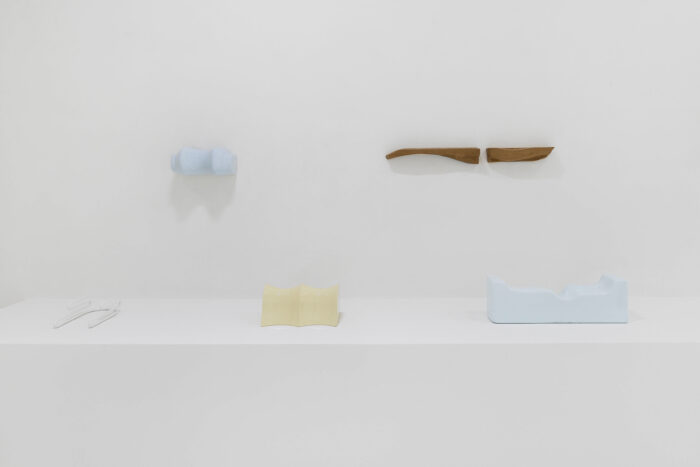
PERSPECTIVES FOR AN UNINTERRUPTED CONSTRUCTION OF THE FUTURE
SHORELINE
Before the Sumerians invented writing, the inhabitants of ancient Europe decorated temples, sculptures, ceramic figurines and ritual artifacts with symbols and abstract signs. Originally, each of these symbols indicated an object: for instance, parallel spiral lines could represent the flow of water and its waves. Signs such as “V” covered vessels and other ritual artifacts and referred to the same cult. The Neolithic Mother Goddess was probably derived from the Upper Paleolithic U sign.
Following in the footsteps of ruins, ecological entities and landscapes, the title of the exhibition VU – betrays a votive significance. It is an interference of space and time in the human habitat—(Mediterranean) imagination. Alessandro Vizzini’s interest in archaeology, anthropology, geology and mythology spills over into the horizon—perspectives for an uninterrupted construction of the future. In his formal and speculative work, a desire suspended amidst the sky, the earth and the sea emerges: enter the SHORELINE. In this process, the symbols in the title become intermediaries, “symbols of old symbols” which, as syntheses of multiple realities, reveal an interruption, as the narrative consistency of archives breaks down. The works appear as within a stratified hypogeum, a mental landscape that follows a temporal fracture and a spatial sedimentation.
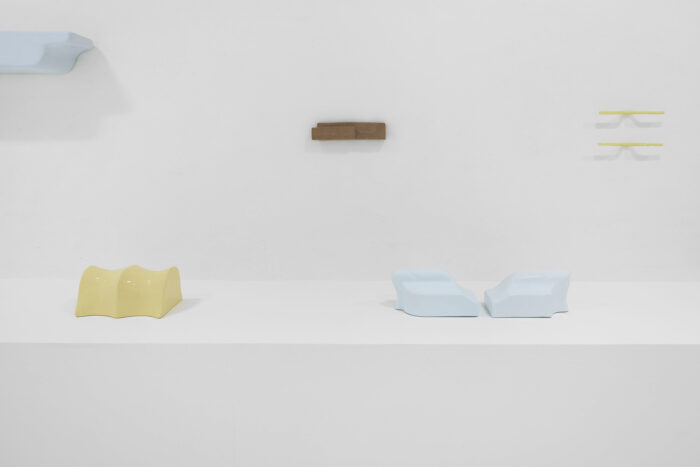
The artist’s personal memory of his physical movements—from Sardinia to the mainland, or along the urban routes of the cities he inhabits—is overlaid with biological memories of places encountered or sought out on the Mediterranean coast. They are findings and fragments of a physical and spiritual nature. Oneiric anastyloses compose and decompose reality. Right from its title, each work is a distillation of a journey, a drift-horizon whereby the narrative of reality materializes in filaments of memories and visions, forms higher than mere merchandise emerging from the landscape.
Each sculpture represents a specific subject in the landscape, which, once reworked with a psychogeographical approach and made to generate hypertextual links that make any correspondence of modern human logic alien, involves a reversal of connections among physical, emotional and aesthetic experience. The sculptures are conceived and arranged as defunctionalized objects halfway between works of design and ritual relics which, while playing with pareidolic perception, are articulated throughout the exhibition as “devices for the imagination.”
Observations
Reflections
Mirages
Landscapes
Projections
Dreams
Building on about six years of research, Vizzini’s works offer a negotiation between human vision and its cognitive construction and decoding, thus showing the illusions of memory, the fictions of reality and the end of nature as we know it. This work also shows the illusion of perception and comprehension attempts based on the entity of sculpture, as each work is presented as an illusion—between archaeology and design—of a multiple or a reproduction, but none of the sculpture-objects presented is the same as the other.
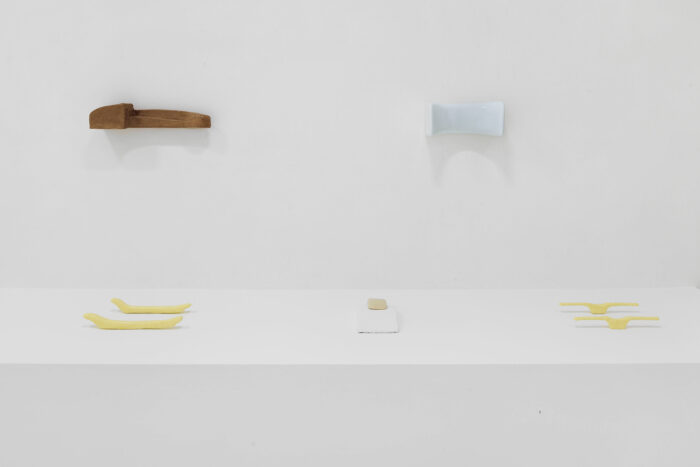
On the contrary, in addition to their shapes, they show small diffractions in the color gradations and viscosity [1] of glossy or semi-glossy material, from which the traces of the artist’s hand sometimes emerge, as they crystallize the survival of nature and the human being in their reciprocal relationship, starting from the horizon of the sea. This way, the artist also performs a mythopoeic operation, namely the creation of an imaginary landscape that disrupts the representative logic of materials and archives and opens a portal to new communication. Each object-sculpture encapsulates a fictitious performance of the human body whose reality is hybridized by the landscape’s marine bestiaries, anthropomorphic fictions and mythologies, and urban ecologies in order to make a different story emerge from the hegemonic one.
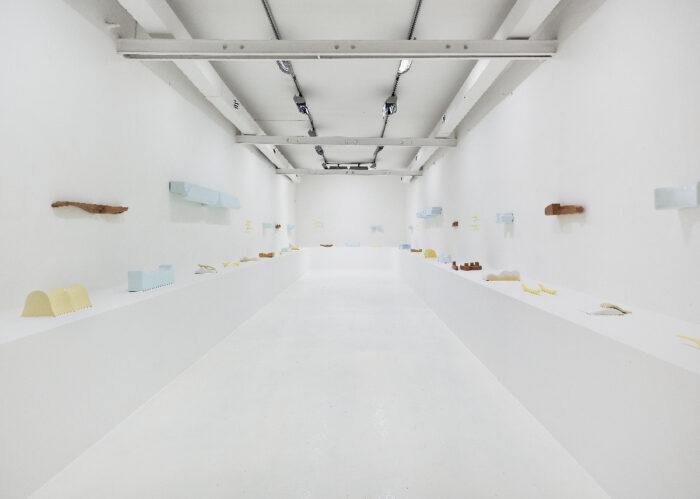
Vizzini complements the one-directional movement of present, past and future with connections of lines, movements, and displacements, while introducing imaginary animals and Egyptian headrests; he ponders over horizons, sycophancies, dunes, travelers of multiple temporalities… In the words of Gilbert Simondon, “this structure of the landscape derives from a magical mode of existence that comes before technicism (and religion), but which survives in various places and practices. It is also an earlier mode of existence that points to a future mode to come. […] it can involve these circuits back and forth in time, circuits that are often activated by a journey or pilgrimage of some kind through and into a landscape.”
[1] This word is suggested by the artist in reference to Timothy Morton’s use of the term “hyperobjects”




